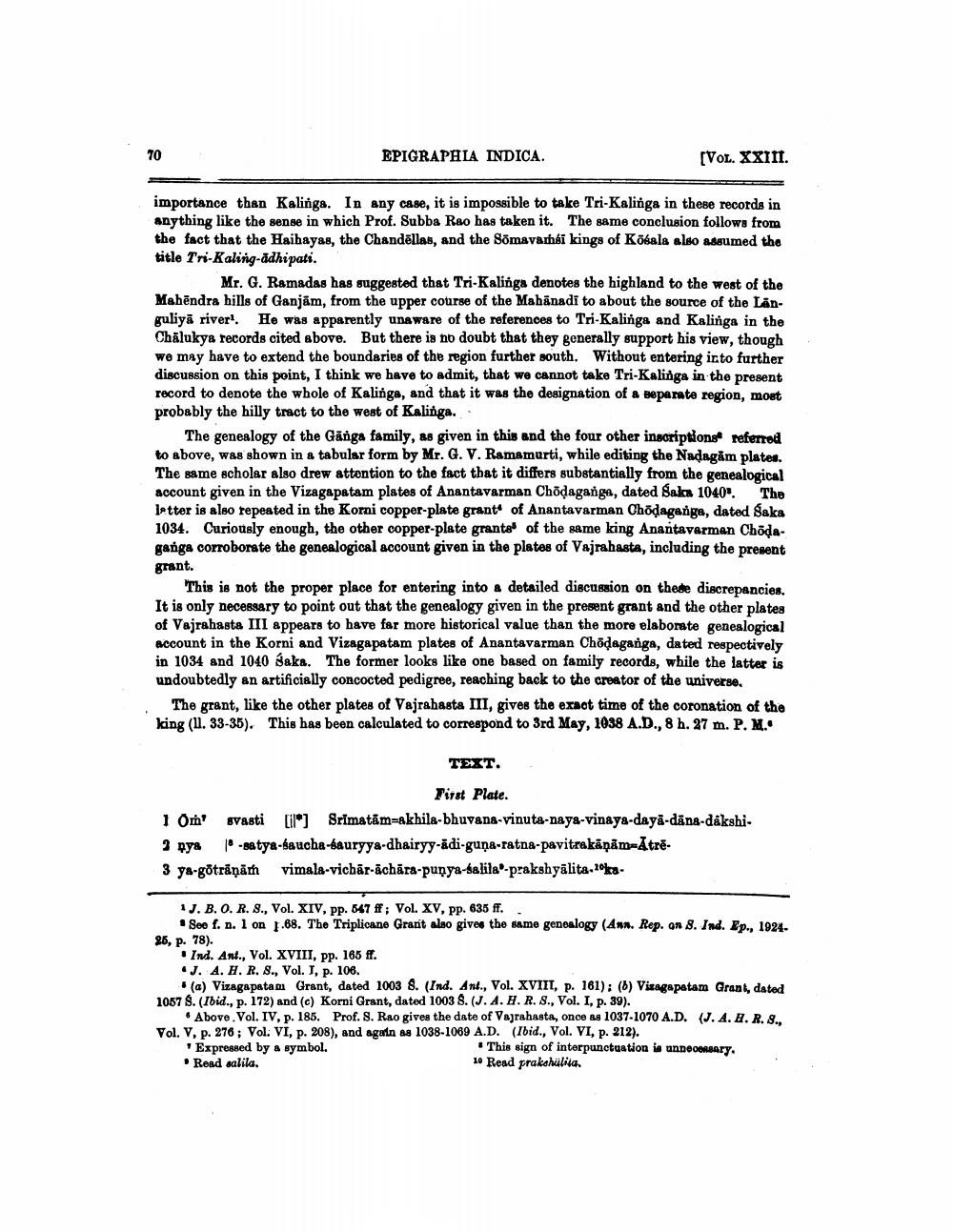________________
70
EPIGRAPHIA INDICA.
(VOL. XXIII.
importance than Kalinga. In any case, it is impossible to take Tri-Kalinga in these records in anything like the sense in which Prof. Subba Rao has taken it. The same conclusion follows from the fact that the Haihayas, the Chandēllas, and the Somavamsi kings of Kobala also assumed the title Tri-Kaling-adhipati.
Mr. G. Ramadas has suggested that Tri-Kalinga denotes the highland to the west of the Mahēndra hills of Ganjām, from the upper course of the Mahanadi to about the source of the Languliyā river'. He was apparently unaware of the references to Tri-Kalinga and Kalinga in the Chālukys records cited above. But there is no doubt that they generally support his view, though we may have to extend the boundaries of the region further south. Without entering in to further discussion on this point, I think we have to admit that we cannot take Tri-Kalinga in the present record to denote the whole of Kalinga, and that it was the designation of a separate region, most probably the hilly tract to the west of Kalinga.
The genealogy of the Gänga family, as given in this and the four other inscriptions referred to above, was shown in a tabular form by Mr. G. V. Ramamurti, while editing the Nadagam plates. The same scholar also drew attention to the fact that it differs substantially from the genealogical account given in the Vizagapatam plates of Anantavarman Chodaganga, dated Saka 1040". The latter is also repeated in the Korni copper-plate grant of Anantavarman Chodaganga, dated Saka 1034. Curiously enough, the other copper-plate grants of the same king Anantavarman Chödaganga corroborate the genealogical account given in the plates of Vajrahasta, including the present grant.
This is not the proper place for entering into a detailed discussion on these discrepancies. It is only necessary to point out that the genealogy given in the present grant and the other plates of Vajrahasta III appears to have far more historical value than the more elaborate genealogical account in the Korni and Vizagapatam plates of Anantavarman Chödaganga, dated respectively in 1034 and 1040 Saka. The former looks like one based on family records, while the latter is undoubtedly an artificially concocted pedigree, reaching back to the creator of the universe.
The grant, like the other plates of Vajrahasta III, gives the exact time of the coronation of the Icing (11. 33-35). This has been calculated to correspond to 3rd May, 1038 A.D., 8 h. 27 m. P. M.
TEXT.
First Plate. 1 Om' svasti [ll] Srimatām-akhila-bhuvana-vinuta-naya-vinaya-daya-dana-dakshi3 nya * -satya-baucha-kauryya-dhairyy-idi-guna-ratna-pavitrakāņām-Atre3 ya-gðtrāņām vimala-vichār-achāra-punya-balila-prakshyālita.oka.
1J. B.O.R.S., Vol. XIV, pp. 547 ff ; Vol. XV, pp. 635 ff..
See f. n. 1 on 1.68. The Triplicane Grant also gives the same genealogy (Ann. Rep. on 8. Ind. Ep., 192425, p. 78).
• Ind. Ant., Vol. XVIII, pp. 165 ff.
J. A. H. R, S., Vol. I, p. 108.
(a) Vizagapatam Grant, dated 1003 8. (Ind. Ant., Vol. XVIII, p. 161): () Vizagapatam Grant, dated 1057 S. (Ibid., p. 172) and (c) Korni Grant, dated 1003 8. (J. A.H.R. S., Vol. I, p. 39).
Above. Vol. IV, p. 185. Prof. 8. Rao gives the date of Vajrahasta, onde as 1037-1070 A.D. (J. A. H. R. 8.. Vol. V, p. 276; Vol. VI, p. 208), and again as 1038-1069 A.D. (Ibid., Vol. VI, p. 212). Expressed by a symbol.
• This sign of interpunctuation is unnecondary. . Read salila.
10 Read prakshüliia.




